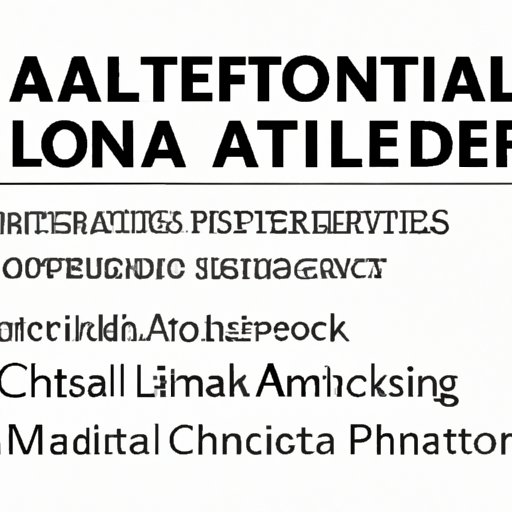Introduction
Citing sources accurately is an essential part of academic writing, and textbooks are no exception. Whether you are writing a research paper, an essay, or a thesis, citing a textbook is necessary to acknowledge the author’s ideas and to support your own. In this article, we’ll provide you with a comprehensive guide on how to cite a textbook. We’ll cover the most common citation styles: MLA, APA, Chicago, and Harvard Referencing formats.
The Basics of Citing a Textbook in MLA Style: A Quick Reference
MLA (Modern Language Association) is the most commonly used style for citing sources in the humanities. When citing a textbook in MLA Style, you need to include the following basic elements:
– Author’s name(s)
– Title of the textbook
– Publisher
– Date of publication
Here is an example of an MLA citation for a textbook:
Last Name, First Name. Title of Textbook. Publisher, Publication Year.
For example:
Johnson, Robert. Biology Textbook. Pearson, 2019.
A Step-by-Step Guide to Citing a Textbook in APA Format
APA (American Psychological Association) format is often used in social science research. To cite a textbook in APA Format, follow these steps:
1. Begin with the author’s last name, followed by a comma and their first initial.
2. Next, include the publication date in parentheses.
3. Then, write the title of the textbook in sentence-case, followed by a period.
4. Next, include the publisher’s location, followed by a colon.
5. Finally, include the name of the publisher, followed by a period.
Here is an example of an APA citation for a textbook:
Author, A. A. (Year of Publication). Title of textbook. Publisher Location: Publisher Name.
For example:
Johnson, R. (2019). Biology Textbook. Boston, MA: Pearson.
Understanding the Various Citation Styles: How to Cite a Textbook in Chicago Style
Chicago style is often used in historical research, and it has two citation styles: Author-Date and Notes-Bibliography. When citing a textbook in Chicago style, you need to include the following basic elements:
– Author’s name(s)
– Title of the textbook
– Publisher
– Date of publication
Here is an example of a Chicago citation for a textbook using the Author-Date style:
Last Name, First Name. Year of Publication. Title of Textbook. Publisher.
For example:
Johnson, Robert. 2019. Biology Textbook. Pearson.
And here is an example of a Chicago citation for a textbook using the Notes-Bibliography style:
Last Name, First Name. Title of Textbook. Publisher, Year of Publication.
For example:
Johnson, Robert. Biology Textbook. Pearson, 2019.
An Expert Guide on Citing a Textbook in Harvard Referencing Format
Harvard referencing format is commonly used in the sciences. When citing a textbook in Harvard referencing format, you need to include the following basic elements:
– Author’s name(s)
– Year of publication
– Title of the textbook
– Edition number
– Publisher
– Place of publication
Here is an example of a Harvard citation for a textbook:
Last Name, First Initial. (Year Published) Title of Textbook. Edition number. Place of publication: Publisher.
For example:
Johnson, R. (2019) Biology Textbook. 3rd ed. Boston: Pearson.
Common Mistakes to Avoid When Citing a Textbook in Academic Writing
While citing a textbook may seem straightforward, students often make mistakes that could affect the accuracy and integrity of their work. Here are some common mistakes to avoid when citing a textbook:
– Leaving out a required element, such as the publisher or the date of publication
– Inaccurately citing the author’s name or the title of the textbook
– Citing a textbook that you haven’t used in your work
– Copying and pasting a citation from another source without verifying its accuracy
– Failing to cite a textbook at all
To avoid these mistakes, make sure you carefully read and follow the guidelines for the citation style you are using.

Why Accurate Citations Matter: The Importance of Referencing a Textbook
Citing sources accurately is crucial for several reasons. First, it allows readers to trace the source of your information and to verify its reliability. Second, it demonstrates your understanding of the subject and the depth of your research. Finally, and perhaps most importantly, it helps you avoid plagiarism. Plagiarism, or the act of taking someone else’s work and passing it off as your own, can have serious consequences in academic and professional settings. By citing sources accurately and appropriately, you demonstrate your academic integrity and ensure the credibility of your work.
The Ultimate Textbook Citation Cheat Sheet for Any Citation Style
Here is a quick reference guide for citing a textbook in each of the four citation styles covered in this article:
MLA:
Last Name, First Name. Title of Textbook. Publisher, Publication Year.
APA:
Author, A. A. (Year of Publication). Title of textbook. Publisher Location: Publisher Name.
Chicago (Author-Date):
Last Name, First Name. Year of Publication. Title of Textbook. Publisher.
Chicago (Notes-Bibliography):
Last Name, First Name. Title of Textbook. Publisher, Year of Publication.
Harvard:
Last Name, First Initial. (Year Published) Title of Textbook. Edition number. Place of publication: Publisher.
Conclusion
In conclusion, citing a textbook is an essential part of academic writing, and it is crucial to cite sources accurately and appropriately. In this article, we have covered the basic elements of the most common citation styles: MLA, APA, Chicago, and Harvard referencing formats. We have also provided examples of textbook citations in each format, highlighted common mistakes to avoid, and discussed the importance of referencing accurately. We hope this guide has been helpful and that you will use it to ensure the credibility and integrity of your academic work.
